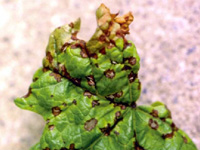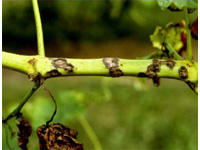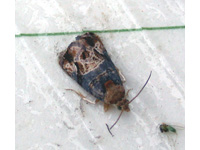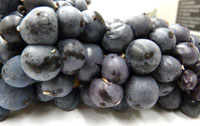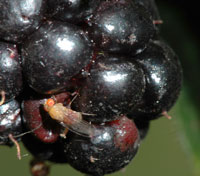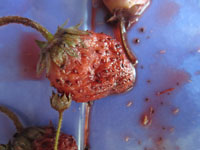Extension > Garden > Diagnose a problem > What's wrong with my plant? > Fruit > Grape > Fruit rotten or shriveled
Grape > Fruit > Fruit rotten or shriveled
1 of 5
Anthracnose (Bird’s Eye Rot)
Elsinoe ampelina
- Berries develop small, reddish circular spots that average 1/4 inch in diameter that may become sunken with a dark brown to black margin, resembling a “bird’s eye”
- Berries are susceptible from bloom to veraison
- Infected shoots develop spots that become sunken lesions with gray centers and dark reddish-brown raised edges
- Infected shoots may be confused with hail damage; but unlike hail damage, the edges of the lesions are raised and black
- Leaves develop circular lesions with gray centers and brown or black margins, the center of the leaf spot may fall out resulting in small ragged holes in the leaf
- Infection is more prevalent in rainy years
- More information on Anthracnose (Bird’s Eye Rot)
2 of 5
Grape Berry Moth
- Larva feeding results in the fruit having a hole that appears “ripped”, with the berry eventually drying out
- Dark tunnels may be apparent from larvae feeding just below the skin
- Larvae present from June through August
- Larvae feed on stems, blossom buds, and berries
- Late instars are green to purple in color, and are 1/3 inch in length when fully grown
- More information on Grape Berry Moth
3 of 5
Black Rot
Guignardia bidwellii
- Berries that have been infected for several days dry up, shrink and wrinkle into a bluish black ‘mummy’ that remains attached to the cluster
- A red ring appears on berries, this grows quickly until the entire berry is brown
- Multiple berries in a cluster can be infected
- Symptoms on berries commonly show up when the fruit is half grown
- Leaves have round tan spots with dark edges, tiny black pimples are often visible in the center of the spot
- Black slightly sunken ovals or short streaks can be seen on Infected young green vines, leaf and flower stalks
- More information on Black Rot
4 of 5
Spotted Winged Drosophila
Drosophila suzukii
- Active in gardens from July to September
- Larvae feed on healthy, intact, ripening fruits
- Fruit becomes soft and decays
- Adult flies are small (1/8 - 1/12 inch) long, yellowish-brown and red eyes, larvae are small (1/8” long), white and cylindrical
- More information on Spotted Winged Drosophila
5 of 5
Phomopsis Cane and Leaf Spot
Phomopsis viticola
- Fruit will turn light brown and shrivel, small raised black pimple like structures may be visible on the fruit surface
- Symptoms on berries are most obvious close to harvest on maturing fruit
- Leaves may be puckered along the veins or the margins may be turned under
- Dark brown spots with yellow edges can also appear along leaf veins and petioles, the lower leaves are most commonly affected
- More information on Phomopsis Cane and Leaf Spot




